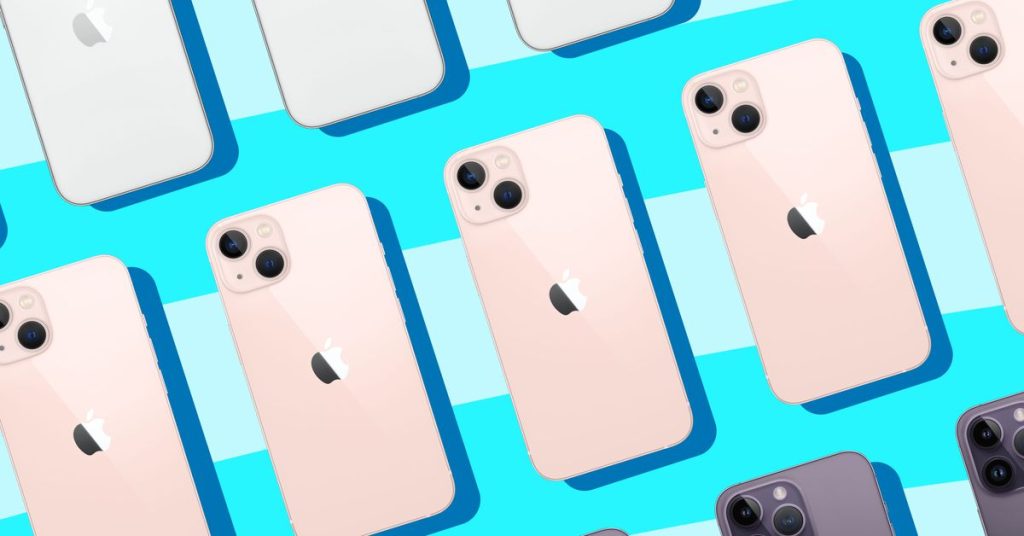
Picking a new iPhone feels like it should be simple. But like so many other modern problems (have you tried simply choosing something to watch on TV lately — an impossible task) it’s a little more complicated than it seems. Counting previous models that are still hanging around, along with all the Pros and Pluses and Maxes, Apple currently sells eight different iPhone models on its website. Eight! It’s almost as confusing as trying to buy an iPad.
But fear not; there’s help. After plenty of thorough testing, day-to-day use, and many blue chat bubbles, I’m here to help you navigate Apple’s extensive product catalog. Whether you want an iPhone that will get through two days on a single battery charge, one that truly fits in your pocket, or the least expensive iPhone you can buy, we’ve got recommendations.
The best iPhone to buy in 2023
Best iPhone for most people
Yes, you read that right. If you’re buying an iPhone in early 2023, the smartest choice might just be 2021’s iPhone 13. This is especially true if you’re paying some or all of the cost out of pocket and not getting an “iPhone on us” carrier deal. If you want the very latest and greatest, then it’s worth skipping up to the 14 Pro or Pro Max — more on that below. But the regular iPhone 14 is such a minor update to the 13 that you might as well save an extra $100 and just go with the (still excellent) previous-gen model.
In the iPhone 13, you still get an Apple A15 Bionic chipset, a 6.1-inch OLED screen, wireless charging via MagSafe, and an IP68 rating. Opting for the iPhone 14 gets you a slightly upgraded camera and a version of the A15 with an extra GPU core plus a new satellite SOS feature that will let you message emergency services even when you’re out of cell range. Nice, but is that all an extra $100 nice? That’s up to you: on a 36-month payment plan, it doesn’t add up to much more on your monthly bill — only about $3. If you’re paying upfront, though, it might feel better to keep that extra cash in your wallet. You can use it to buy something nice, like a few dozen eggs.
As it is, the iPhone 13 is plenty fast for most people, takes generally great photos and video, and will keep receiving OS updates well into the foreseeable future thanks to Apple’s habit of supporting devices with new iOS versions for upward of five or six years.
$699
With the introduction of the iPhone 14, Apple lowered the price on the 13 to $699. If you’re paying upfront rather than subsidizing your purchase with a carrier, then this is the best bang for your buck in 2023.
Best high-end iPhone
Apple iPhone 14 Pro and 14 Pro Max
If cost isn’t a major concern or you’re able to snag a good carrier deal on a new iPhone, then this is a good year to spring for the top-tier model. The 14 Pro and 14 Pro Max get a new main camera sensor with some useful upgrades, an all-new A16 Bionic chipset, an always-on display, and a new UI element called Dynamic Island that puts certain timely system and app info at the top of your screen.
None of it is exactly life-changing, but they’re features that Apple is almost certainly going to incorporate in new models going forward, and third-party app makers will follow suit. It’s the iPhone to get if you suffer from technology FOMO.
The 14 Pro and Pro Max back up those new features with all-around great performance. They differ in screen size — the 14 Pro offers a 6.1-inch display and the Pro Max goes big with a 6.7-inch screen — but they’re both ProMotion displays with up to 120Hz refresh rate for super-smooth scrolling. The Pro Max has a bigger battery, too, but aside from those differences, the two phones are largely the same. There’s a new 48-megapixel main camera sensor with a neat 2x lossless crop zoom mode in addition to a dedicated 3x telephoto camera. It all adds up to a very capable camera system with some of the best video quality you’ll find on any phone anywhere.
$999
The iPhone 14 Pro ushers in some new ideas from Apple, making it kind of an early adopter special. If it’s time to upgrade and you want all the latest and greatest features, then you’ll need to go Pro.
$1099
The 14 Pro Max is the bigger sibling to the 14 Pro, with a large 6.7-inch screen. Otherwise, it shares the same features as the smaller model, including the new Dynamic Island status indicator and a 48-megapixel main camera.
Best small iPhone
Apple released the iPhone 12 and 13 in two sizes: one with a 6.1-inch screen and a Mini variant with a comparatively petite 5.4-inch screen. They kind of bombed, so there’s no iPhone 14 Mini. But like the iPhone 13, Apple still sells the 13 Mini new — and it might be your last chance to get this small screen form factor before it disappears off the company’s retail shelves completely.
Aside from a smaller screen and battery, the 13 Mini includes everything we like about the 13 — good cameras, a speedy A15 Bionic processor, a robust IP68 rating for water and dust resistance, and MagSafe for accessories and wireless charging. Did we mention that it fits all the way into your pants pocket? Just try that with a Pro Max.
There is one major downside: the 13 Mini’s battery life isn’t great. It’s good enough to get through a day of moderate use, but if you do a lot of battery-intensive things on your phone like recording 4K video or gaming, then you’ll need to top it off during the day. Anyway, most people looking for a small phone probably don’t rank mobile gaming high on their list of priorities, so it’s likely not a concern for the Mini’s target demographic.
$599
The iPhone 13 Mini has all the features and cameras of its bigger siblings, just in a smaller package. It has a 5.4-inch display, 128GB of storage, a smaller battery, and the same A15 Bionic chip as other iPhone 13s.
Best cheap iPhone
The third-gen iPhone SE, released in 2022, is sort of the default winner in this category. It’s the least expensive iPhone you can buy, and for its $429 starting price, it includes some major feature upgrades most midrange phones don’t offer, like wireless charging, a flagship processor, and an IP67 rating for good water and dust resistance. For sheer ROI, the iPhone SE is a fantastic choice.
But this recommendation comes with some big caveats, starting with the screen. It’s small — at 4.7 inches, it’s significantly smaller than the iPhone 13 Mini’s display, even though the SE is slightly taller and wider than the Mini. That’s because the 2022 SE uses a very old iPhone design that dates back to the iPhone 6S. The screen feels cramped, and the LCD technology looks dated. It’s also the only iPhone left that retains the home button and its fingerprint scanner rather than Face ID, which might be preferable if you hate gesture navigation. Most of us are getting along just fine without a home button, so this one is really down to personal preference.
There are a couple of other low points: the camera system doesn’t have a night mode, and there’s only 64GB of storage on the base model. But if you’re accustomed to a bigger phone screen, that 4.7-inch LCD might be the thing that’s hardest to live with. There are also rumors of an iPhone SE in 2024 with a 6.1-inch OLED screen — big if true, literally. That’s an upgrade worth waiting another year for if you can hold off. But if a small screen doesn’t bother you, then there’s no better deal than the iPhone SE.
$429
The 2022 iPhone SE will last for over five years if it’s taken care of thanks to Apple’s excellent track record of offering iOS updates to older devices. But its tiny 4.7-inch screen feels cramped now and may be tough to use in five years’ time while apps and webpages continue to be designed for bigger screens.
iPhone with the best battery life
When the iPhone 14 series went on sale in September 2023, there was one model missing: the 14 Plus. It was announced at the same time as the other three devices but wasn’t available until three weeks later when a lot of the new-phone fanfare had died down. That’s a shame, too, because the 14 Plus has one legitimately great upgrade over the 13: excellent battery life.
That’s sort of a byproduct of another feature: a big 6.7-inch screen, the same size as the Pro Max’s display. Makes sense: a bigger screen makes for a bigger phone, which means more room for a bigger battery. But the Plus’ battery stamina is particularly good because its screen, with its standard refresh rate and no always-on display, isn’t as power-hungry as that of the Pro Max. In any case, the 14 Plus can get through two full days of light use before you need to charge the battery. The Pro Max can’t touch that.
The 14 Plus has the same minor upgrades as the regular 14, too, like the satellite emergency messaging and an upgraded main camera. But with the screen size and battery advantage, it feels like a phone that’s worth spending a little extra on, whereas the 14 doesn’t quite meet that bar.
$899
The iPhone 14 Plus offers a big 6.7-inch screen size that has — at least in recent history — been reserved for the Pro Max. With a big screen comes a big battery, and it can power the 14 Plus through two days of light use.

 Latest Breaking News Online News Portal
Latest Breaking News Online News Portal




